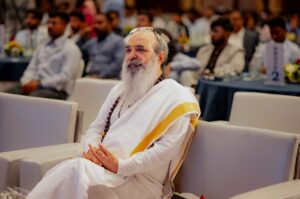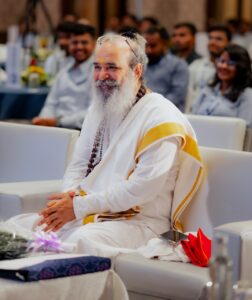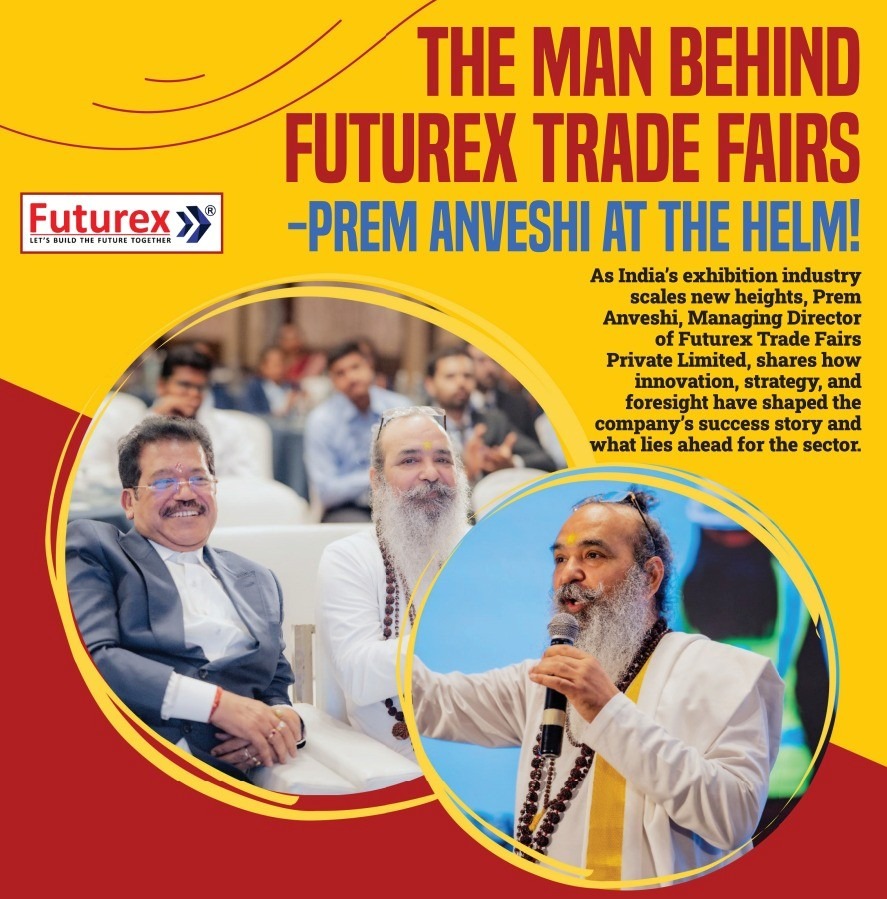The Man behind Futurex Trade Fairs – Prem Anveshi at the helm!
As India’s exhibition industry scales new heights, Prem Anveshi, Managing Director of Futurex Trade Fairs Private Limited, shares how innovation, strategy, and foresight have shaped the company’s success story and what lies ahead for the sector.
TFT: Futurex Trade Fairs has been organizing expos around the world for a very long time. Please tell us something about the company!
Prem Anveshi – At Futurex Trade Fair and Events, we believe that business growth happens when people come together, share ideas, and build lasting connections. Over the years, we’ve had the privilege of organizing over 200 international exhibitions and conferences across various industries, including Corrupack, mining, building & infrastructure, wood and woodworking, agriculture, power, plastics, packaging, pharma, and more. Each event we create is designed to give businesses a stage to showcase their work, meet potential buyers, and explore fresh opportunities.
What sets us apart is not just the scale of our events, but the personal touch and care we bring to every detail. Our team works closely with clients to understand their unique goals and deliver experiences that are both meaningful and cost-effective, while also being sustainable. From startups looking to make their mark, to established companies aiming to expand globally — we’re here to make that journey smoother and more rewarding.
For us, exhibitions aren’t just about stalls and spaces — they’re about stories, connections, and possibilities. That’s why industry professionals see Futurex as a trusted partner, one that combines professionalism with passion and consistently brings the world closer to their business.
Futurex — Let’s Build the Future Together.

TFT: What are the flagship exhibitions of Futurex, and what new shows can we expect in the coming years?
Prem Anveshi – Futurex Trade Fair & Events Pvt. Ltd. has, over the years, grown into a name that industries trust when it comes to building meaningful platforms. Their exhibitions aren’t just about booths and displays — they are about creating spaces where people, ideas, and opportunities come together. From mining, woodworking, construction, and EV/green mobility to plastics, packaging, energy, and their signature “Buildcon” and “Wood” series, every Futurex show is designed to bring the entire ecosystem under one roof. It’s where manufacturers meet buyers, technology providers meet innovators, and conversations turn into collaborations.
Among their most exciting upcoming events is the Corru Pack Print India Expo 2026, happening from 19–22 March 2026 at the Bombay Exhibition Centre (NESCO), Goregaon, Mumbai. This is more than just an exhibition — it’s the second edition of India’s only dedicated show for corrugated packaging machinery and allied technologies, organized alongside ICPMA. What makes this event special is its energy: the sound of machines running live demos, the sight of new printing and converting lines in action, and the buzz of professionals exchanging ideas across aisles. From raw materials like inks and paper to cutting-edge automation and quality testing systems, the diversity is immense. Add to that panel discussions, buyer–seller meets, and international delegations — and it becomes clear why this show is set to be a global meeting point for the packaging world. With over 250+ live machines expected and a scale three times bigger than its debut, Corru Pack Print 2026 is a celebration of how packaging is evolving with e-commerce, FMCG, and logistics.
Equally important is the Odisha Mining & Infrastructure International Expo 2026, which will mark its 4th edition in Bhubaneswar. Over time, this event has become a flagship platform for India’s mining and infrastructure sector — not only showcasing heavy machinery and technologies but also sparking conversations around sustainability, development, and the future of resources. It’s where policymakers, global buyers, technology experts, and industry leaders come together to shape what’s next for one of India’s most vital industries.
With flagship events like these, Futurex isn’t just organizing trade fairs — it’s building bridges between industries and people. Our shows are designed to feel alive, to inspire progress, and to make sure that every participant walks away with new ideas, new partners, and new possibilities.

TFT: You have been organizing expos globally. What are the things that differentiate the Indian Market from the Global Market?
Prem Anveshi – That’s a really interesting question, and honestly, India feels like a world of its own when it comes to exhibitions. The biggest difference we see is that the Indian market is still in this fast-growing, discovery phase. Globally, many markets are already mature — people know exactly what they’re looking for, deals are very structured. But in India, exhibitions are as much about learning and exploring as they are about buying. Another thing that makes India stand out is the variety of people you meet on the show floor. You’ll have large industry leaders sharing space with small entrepreneurs, first-time business owners, and even students who just want to understand what’s happening. That mix creates an energy that’s very hard to find anywhere else.In India, people are also very value-conscious — they want solutions that are affordable, practical, and sustainable. This means exhibitors have to not only showcase products but also really connect, explain, and build trust. Globally, decisions can be quicker and more data-driven, but in India, it often starts with a warm conversation and sometimes even a cup of chai.
So if I had to sum it up: the global market runs on systems and predictability, while India runs on energy, diversity, and human connections. And that’s exactly what makes organizing expos here both exciting and incredibly rewarding.

TFT: Are there any new projects in the pipeline at Futurex which we can expect in the coming days?
Prem Anveshi – Are you ready for what’s coming next? Because at Futurex, we sure are — and we’d love to take you along with us. For us, exhibitions have never been just about booths or machines; they’re about people, energy, and discovery. When you step into one of our shows, you don’t just attend — you experience.
We’re kicking things off in December 2025 with a double treat.
First, the 7th India International EV Show (5–7 December, Pune). Imagine walking into a hall buzzing with electric cars, futuristic bikes, battery innovations, and charging solutions — the kind of stuff that makes you stop and think, “Wow, the future is already here.” Then, just a few days later, we’re heading to Kathmandu for the 11th Nepal Wood International Expo (19–21 December, Bhrikuti Mandap). Picture the hum of live woodworking machines, the scent of fresh timber, architects and carpenters huddled together, and new ideas flying around faster than sawdust in the air.
In January 2026, the spotlight shifts to Bhubaneswar with the 4th Odisha Mining & Infrastructure International Expo (8–11 January). This one is big — literally. Think massive mining equipment parked right next to buzzing conversations on sustainability, infrastructure, and the future of India’s growth. It’s not just about machines; it’s about people coming together to tackle the big questions.
By February 2026, we’re back in Kathmandu for the 11th Nepal Buildcon International Expo (5–8 February). Here, it feels like stepping into the future of cities — everything from heavy construction machinery to interiors, urban design, and smart solutions. If you’re a builder, planner, or dreamer, this is where your ideas find wings.
And then comes the grand finale in March 2026 — the Corru Pack Print India Expo in Mumbai (19–22 March). Imagine 250+ machines running live, people from across continents shaking hands in buyer–seller meets, and innovation in packaging that makes you rethink the box itself. It’s the only dedicated corrugated packaging show in India, and this year it’s three times bigger. Walk in, and you’ll literally feel the pulse of an industry in transformation.
Each of these expos has its own personality, but together they tell one story: that exhibitions are about more than products — they’re about people, possibilities, and progress. So, the question is… which chapter will you be part of?
TFT: Futurex is known for organizing large-scale international exhibitions. What makes your approach unique compared to others in the industry?
Prem Anveshi – What makes us different? Honestly, it’s the way we look at exhibitions. For many, an expo is about putting up booths, machines, and banners. For us at Futurex, it’s about creating a space that feels alive. When you walk into one of our shows, we don’t want you to just see products — we want you to feel the energy of the industry. The buzz of live machines, the excitement of a first-time entrepreneur meeting a global buyer, the spark of an idea born over a quick coffee — those are the moments we build for. We also believe exhibitions should be about people, not just products. That’s why we work hard to bring the entire value chain together — manufacturers, innovators, buyers, policymakers, and even young students exploring the industry for the first time. When all these voices come together in one place, magic happens. Ideas flow, partnerships form, and businesses grow in ways they never expected.
And maybe the biggest difference? We listen. Every show we design is shaped by the people who join us. We ask what they need, where the gaps are, and how we can make the experience more valuable. That’s why our events don’t just repeat year after year — they evolve, just like the industries we serve.
So yes, we organize exhibitions. But more importantly, we create journeys that connect people, open doors, and spark growth. That’s what makes the Futurex experience unique.
TFT: What are the different challenges you face while organizing exhibitions in the Indian Market and even out of India?
Prem Anveshi – Every exhibition has its own journey, and with that come challenges that teach us something new each time.
In India, the first challenge is actually a beautiful one — the diversity of people who walk through our doors. At a single show, you might meet a large corporate buyer, a small-town entrepreneur looking for opportunities, and even students eager to learn about the industry. It’s amazing, but it also means we have to design our events so that everyone leaves with value, no matter their size or background. Then there’s the practical side — infrastructure and logistics. India is moving fast, but handling big venues, traffic, connectivity, and ensuring smooth experiences for thousands of visitors is always a juggling act. And of course, we know our audience here is very value-conscious — people expect a lot, and rightly so. That keeps us on our toes to make sure exhibitors and visitors feel their time and money were well invested.
Outside India, the challenges feel different. International markets are often more mature and specialized, but markets like Nepal, Bangladesh, Sri Lanka, Bhutan, Kenya, Uganda, Tanzania, and Oman are still developing, but expectations are very high. Everything has to be precise, professional, and tailored to niche industries. On top of that, there are local regulations, cultural nuances, and compliance rules that we need to respect and adapt to. And let’s not forget — we’re often competing with global exhibition giants who have been in the space for decades, so we have to bring something fresh, something that makes people notice.
But honestly, we see these challenges as part of the thrill. They push us to innovate, to listen more carefully, and to grow with every show we do. At the end of the day, whether it’s in Bhubaneswar, Mumbai, Kathmandu, or anywhere else in the world, the heart of it remains the same — creating platforms where people connect, ideas spark, and businesses move forward.
TFT: What are your thoughts on India’s current exhibition infrastructure compared to other global markets?
Prem Anveshi – If you’ve been to an exhibition in India recently, you’ve probably noticed how much things have changed. Step into Jio World Convention Centre in Mumbai, walk through Yashobhoomi in Dwarka, explore India Expo Mart in Greater Noida, or the new halls at Pragati Maidan, and you’ll see spaces that can finally host shows of truly global scale. Just a decade ago, we were constantly working around limitations — smaller venues, patchy facilities, and infrastructure that simply couldn’t match the ambition of our exhibitors. Today, the experience feels completely different.
Now, when you compare this with global markets like Germany, Dubai, or Singapore, the gap is still there. Their venues often feel like entire mini-cities — seamlessly connected to airports, hotels, and public transport, with digital systems guiding you from entry to exit. In India, we’re still ironing out challenges like last-mile connectivity, parking, and smooth visitor flow. And I’m sure many of you who’ve attended large expos here have felt that pinch too.
But here’s what makes India special — and I think anyone who’s walked a show floor here would agree — the energy is unmatched. The diversity of people, the curiosity, the eagerness to connect and learn, create an atmosphere you won’t find anywhere else in the world. Pair that natural energy with the rapid infrastructure upgrades already happening, and India isn’t just catching up — it’s on its way to becoming one of the most exciting exhibition destinations globally.
TFT: What sectors in India do you believe have the highest potential to benefit from exhibitions and trade shows?
Prem Anveshi – You know, the beauty of India is that almost every sector has something to gain from exhibitions — but a few really stand out right now.
Take infrastructure and construction. India is literally building its tomorrow — new roads, smarter cities, housing for millions. An exhibition here isn’t just about showing off machinery; it’s where global tech providers sit across the table from local builders and government planners, and suddenly ideas turn into real projects. Then there’s EVs and green mobility. We all see how fast the world is moving toward sustainability, and India is no exception. Exhibitions give EV startups, battery innovators, and component makers the one thing they need most — visibility and collaboration. It’s where a young startup can meet the right investor or partner and completely change its growth path.
Now, one of the most exciting sectors is corrugation and packaging. With e-commerce exploding and FMCG growing at lightning speed, packaging is no longer just a box — it’s about efficiency, branding, and sustainability. At a corrugation expo, you can actually watch machines running live, see new materials being tested, and meet buyers who are actively looking for smarter, greener solutions. It’s one of those sectors where exhibitions make innovation feel tangible. And of course, mining, energy, and power continue to be the backbone of India’s economy. Here, exhibitions become more than displays — they’re platforms for tough conversations: how do we grow while also being responsible, sustainable, and future-ready?
The best part is, exhibitions in India don’t just serve the “big players.” They’re equally powerful for smaller industries — woodworking, interiors, agritech, even education. For many of them, it’s their first real chance to step into a larger marketplace, showcase what they do, and connect with people who can help them grow.
So, if you ask me, sectors like infrastructure, EVs, corrugation, and energy are leading the way — but the truth is, in India, exhibitions are really about unlocking opportunities for everyone, no matter how big or small.
TFT: What support would you like to see from government bodies to strengthen the exhibition industry?
Prem Anveshi – That’s a really meaningful question, because exhibitions have so much potential to boost trade, tourism, and investment in India — but to unlock that fully, we definitely need stronger support from government bodies.
First off, infrastructure. Yes, we have great venues like Yashobhoomi, Pragati Maidan, and India Expo Mart, but imagine if every major metro and even tier-2 cities had modern, world-class exhibition centers, well connected to airports, hotels, and public transport. Exhibitions wouldn’t just stay confined to Delhi or Mumbai — they’d reach places where industries are actually growing on the ground. Then there’s the whole side of policies and permissions. As organizers, we spend so much time navigating approvals, compliance, and paperwork that it sometimes takes away from focusing on what we do best — creating impactful events. If the government could simplify and streamline these processes, it would free us up to deliver even more value to exhibitors and visitors.
Another big thing is promotion. Look at how countries like Germany or Dubai market themselves as global exhibition hubs — they actively invite the world in. India has that same potential, maybe even more, because of our scale and diversity. If the government invested in positioning India as a must-visit exhibition destination globally, it would attract not just exhibitors, but international buyers and investors too. And finally, I’d love to see closer collaboration between government and organizers in sectors that matter most for the country — like EVs, renewables, infrastructure, and agriculture. Exhibitions can be powerful stages to showcase India’s strengths in these areas, but with the right government backing, they could have an even bigger global impact.
At the end of the day, exhibitions aren’t just events. They’re platforms for progress — places where industries connect, deals get signed, and ideas take root. With the right support, India has everything it takes to become one of the world’s top exhibition destinations.


